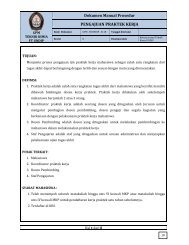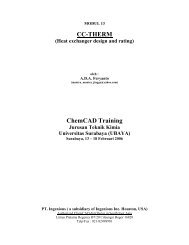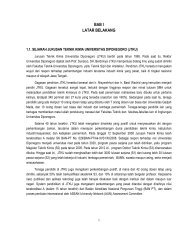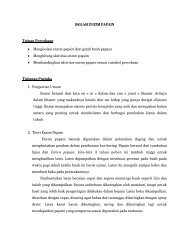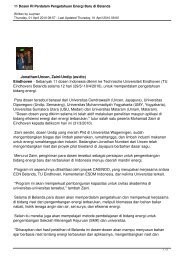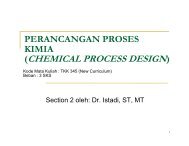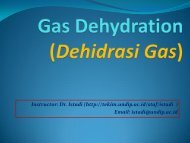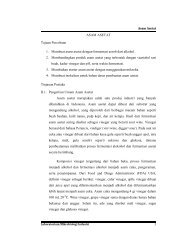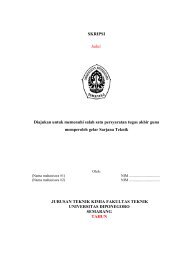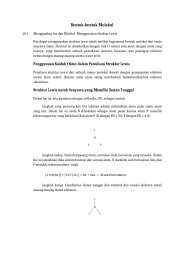4. Natural Gas Liquid Processing and Sulfur Recovery
4. Natural Gas Liquid Processing and Sulfur Recovery
4. Natural Gas Liquid Processing and Sulfur Recovery
Create successful ePaper yourself
Turn your PDF publications into a flip-book with our unique Google optimized e-Paper software.
Teknologi Pemrosesan <strong>Gas</strong> (TKK 564)Instructor: Dr. Istadi(http://tekim.undip.ac.id/staf/istadi )Email: istadi@undip.ac.idid
Instructor’s t Background• BEng. (1995): Universitas Diponegoro• Meng. (2000): Institut Teknologi B<strong>and</strong>ung• PhD. (2006): Universiti Teknologi Malaysia• Specialization:• Catalyst Design for Energy Conversion• Process Design for Energy Conversion• Combustion Engineering• Computational Fluid Dynamic (CFD)
Course Syllabus: (Part 2)1. Hydrocarbons <strong>Recovery</strong> (Pengambilan Kembali Hidrokarbon)2. Nitrogen Rejection/Removal (Penghilangang g Nitrogen))3. Trace Component Removal (Penghilangan Komponenlainnya)<strong>4.</strong> <strong>Natural</strong> <strong>Gas</strong> <strong>Liquid</strong> <strong>Processing</strong> <strong>and</strong> <strong>Sulfur</strong> <strong>Recovery</strong>(Pemrosesan Cairan <strong>Gas</strong> Alam dan Penghilangan <strong>Sulfur</strong>)5. <strong>Gas</strong> Transportation <strong>and</strong> Storage (Transportasi danPenyimpanan <strong>Gas</strong>)6. Liquified <strong>Natural</strong> <strong>Gas</strong> #1 (<strong>Gas</strong> Alam Cair)7. Liquified <strong>Natural</strong> <strong>Gas</strong> #2 (<strong>Gas</strong> Alam Cair)8. Second Assignment9. Ujian Akhir Semester
This chapter discussesprocessing the hydrocarbon liquids<strong>Liquid</strong> stream proceed in a glass planCondensateprocessingNGL processing
CONDENSATE PROCESSING
Two steps of Condensate<strong>Processing</strong>• Water washing to remove salt <strong>and</strong>additives• Condensate stabilization • remaining lighter hydrocarbons are stripped<strong>and</strong> recombined with the gas that leaves theinlet receiver• to produce a bottom product that hasspecifications to be sold as “natural gasoline”or “slop oil”
Sweetening for <strong>Liquid</strong> <strong>Processing</strong>• Ideally, the sulfur compounds go with the light gases strippedin the stabilizer, so that they can be removed ed in gas treating.• Most of the H2S <strong>and</strong> CO2 will be removed along with COS,CS2, <strong>and</strong> mercaptans.• To enhance acid gas removal, sweet natural gas can be usedas a stripping gas.• This process can reduce H2S levels to the 10 ppmv range.However, the cost is increased recycle compression.• If the natural gasoline is sour, the plant can either treat it ortake a price penalty <strong>and</strong> sell the liquid as sour crude.• The price differential between sweet <strong>and</strong> sour crude drives theneed for sweetening.• In many cases, the liquid volumes are low <strong>and</strong> sweetening atthe plant is not justified.
NGL Processsing
Sweetening Method in NGL<strong>Processing</strong>• Amine TreatingMost remove only CO2 <strong>and</strong> H2S . Two amines, DGA <strong>and</strong> DIPA, will removeCOS, but none remove CS2 <strong>and</strong> merchaptans. Amine treating is often usedupstream of caustic treaters to minimize caustic consumption caused byirreversible reactions with CO2.• AdsorptionAble to remove sulfur compounds down to low levels when no water ispresent, which makes it attractive for treating demethanizer bottoms.• Either promoted alumina, 13X or 5A molecular sieve will remove H2S, COS,<strong>and</strong> mercaptans from LPG.• The larger pore 13X is usually preferred because it has a higher capacity• Caustic TreatingRegenerative = sodium hydroxide.Nonregenerative = ZnO, KOH
Regenerative caustic wash <strong>and</strong>water wash.
Chemistry involved in Washing• Air is added to the rich caustic, with a catalyst tooxidize the mercaptan to a disulfide:2RSNa + 1/2 O2 + H2O → RSSR + 2NaOH
Dehydration Process in NGL• Adsorption Processes• Desiccant Dehydration• <strong>Gas</strong> Stripping• Distillation• Absorption
• Currently only two methods are available for dealingwith large quantities of H2S:1. Disposal of the gas by injection into undergroundformations2. Conversion of the H2S into a usable product,elemental sulfur
Properties of <strong>Sulfur</strong>
SULFUR RECOVERY PROCESSES1. Claus Process• All Claus units involve an initial combustionstep in a furnace. The combustionproducts then pass through a series ofcatalytic converters, each of whichproduceselemental sulfur.
• Basic ProcessH2S + 3/2 O2↔ H2O + SO22H2S+SO2↔ 2 H2O + (3/x) SxThe first reaction is a highlyhl exothermic combustionreaction, whereas the second is a more weakly exothermicreaction promoted by a catalyst to reachequilibrium.• Kohl<strong>and</strong>Nielsen(1997)pointoutthatatasulfurpartialpressure of 0.7 psia (0.05 bar) <strong>and</strong> temperaturest bl below700°F (370°C), the vapor is mostly S6 <strong>and</strong> S8, but at thesame partial pressure <strong>and</strong> temperatures over approximately1,000°F (540°C), S2 predominates.
Process
2. CLAUS TAIL GAS CLEANUPBefore sulfur emissions restrictions wereimposed, the offgas from the Claus unit wasflared to convert the remaining H2S to SO2.Now, environmental agencies dem<strong>and</strong> highersulfur recovery than can be achieved with ast<strong>and</strong>ard Claus unit, <strong>and</strong> additional treating of theClaus tail gas is needed. The tail gas cleanupentails either an add-on at the end of the Clausunit or amodification of the Claus unit itself.
• three categories for final sulfur removal(Kohl <strong>and</strong> Nielsen, 1997):• Direct oxidation of H2S to sulfur• Sub-dew point Claus processes• SO2 reduction <strong>and</strong> recovery of H2S
Direct Oxidation of H2S to <strong>Sulfur</strong>Catalytic Reaction :2H2S + O2 → 2S + 2H2OThe selective oxidation catalyst in the third reactordoes not promote the reaction2H2S + 3O2 ↔ 2SO2 + 2H2Oor the reverse reaction of sulfur with H2O3S + 2H2O ↔ 2H2S + SO2Total revovery rate = 99%
Sub Dew‐Point Claus Processes
SO2 reduction <strong>and</strong> recovery of H2S
<strong>Sulfur</strong> Storage• <strong>Sulfur</strong> from the Claus unit is withdrawn as a liquid <strong>and</strong> isgenerally stored <strong>and</strong> transported in the molten state.• A number of potential problems are associated with sulfurstorage, including release of H2S dissolved in the moltensulfur <strong>and</strong> the possibility of sulfur fires, which will producehighly toxic SO2.• <strong>Sulfur</strong> fires. Uncommon, but they can produce large amounts ofSO2.• H2S. Any H2S dissolved in the molten sulfur from the condensersmay be a significant hazard if appropriate p degassing g techniquesare not used.• Corrosion. A wet sulfidic atmosphere can lead to severe corrosionof carbon steel.• SO2. Highly toxic <strong>and</strong> it forms highly corrosive sulfurous acid inthe presence of water.• Static discharge. Because of the excellent insulating properties ofmolten sulphur, static discharge may occur under certainconditions <strong>and</strong> lead to possible fires or explosions.




